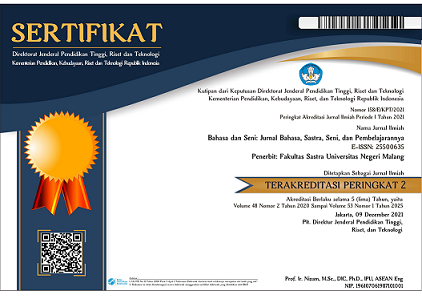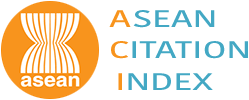PRAGMA-GRAMATIKAL KESANTUNAN HEGEMONIS BAHASA BALI DALAM AWIG-AWIG
Abstract
This study aims to reveal the relation between pragmatics and grammar, especially in Balinese language, which usually has been widely separated. The data were collected through document recording on a number of manuscripts and interviews with informants spreading out over five districts/cities in Bali Province as a representation of dialectal variation. Based on the theory of semantic structure it revealed that grammatical choice was motivated by pragmatic needs to realize Balinese hegemonic politeness in awig-awig of pakraman of the villages. The grammatical choices were: (1) personification of nouns desa, banjar, or subak, i.e. [+ CONCRETE] given the role as noun [+ HUMAN]. This grammatical choice is motivated by the adherence of members to the adat (custom) institutions. (2) Agents' dissipation to accentuate actions, especially those with negative images. This choice of syntactic structure is motivated by the maxim of wisdom and face-saving to reduce threats to someone.
Full Text:
PDFReferences
Arnawa, N. 2016. Struktur Semantik dan Pembatasan Gramatikal: Studi Kasus pada Kalimat Bahasa Indonesia. Prosiding Seminar Nasional Bahasa, Sastra, dan Pengajarannya IV. Universitas Pendidikan Ganesha Singaraja, hal 43 – 52.
Arnawa, N., I W. Gunartha,. I N. Sadwika. 2017. The use of modality markers to perform hegemony politeness in using Balinese language: a case study on Awig-awig. JASL-Journal of Applied Studies in Language: Vol.1 No.1 December 2017, hal. 43 – 51.
Bach, Kent & Robert M. Harnish. 1979. Linguistic Communication and Speech Acts. Cambridge: The Mit Press.
Chafe, W.L. 1972. Meaning and The Structure of Language. Chicago : The University of Chicago Press. Hal 134-161
Djajasudarma, T. F. 2006. Wacana: Pemahaman dan Hubungan Antarunsur. Bandung: PT. Refika Aditama.
Grundy, P. 2000. Doing Pragmatics. New York: Oxford University Press.
Givon, T. 1984. Syntax: A Functional-Typological Introduction. Philadelphia: John Benjamis.
Huang, Yongliang. 2008. Politeness Principle in Cross-Culture Communication. English Language Teaching 1 (1), hal. 96 – 101.
Jie, Wang & Wei Feife. 2016. The Application of Politness Principle in the Analysis of Drama: Take Taechouse as an Example. Cross-Cultural Communication 12.(5), hal. 35 – 38.
Leech.G. 1993. Prinsip-Prinsip Pragmatik. Diterjemahkan oleh M.D.D. Oka. Jakarta: UI Press.
Levinson, S.C. 1989. Pragmatics. Cambridge: Cambridge University Press.
Liu, Lulu. 2017. Application of Cooperative Principle and Politeness Principle in Class Question-answer Process. Theory and Practice in Language Studies, 7(7), hal. 563-569.
Lubis, A.H.H. 1993. Analisis Wacana Pragmatik. Badung: Angkasa.
Marzuki. 1986. Metodologi Riset. Yogyakarta: BPFE – UII.
Mashun. 2005. Metode Penelitian Bahasa. Jakarta: Rajagrafindo Persada.
Nababan, P.W.J. 1987. Ilmu Pragmatik Teori dan Penerapannya. Jakarta: Departemen Pendidikan dan Kebudayaan, P2LPTK.
Olaniyi, Kaseem. 2017. Politeness Principle and Ilorin Greetings in Nigeria: A Sociolinguistic Study. International Journal of Society, Culture & Language, 5(1), hal. 58 – 67.
Owens, Jr. R.E. 1992. Language Development An Introduction. New York: macmillan Publishing Company.
Patria, N. & A. Arief. 2015. Antonio Gramsci, Negara dan Hegemoni. Yogyakarta: Pustaka Pelajar.
Peraturan Pemerintah Daerah Provinsi Bali Nomor 3 tahun 1992.
Piller, I. 2016. Monolingual Way of Seeing Multilingulism. Journal of Multicultural Discourses., 11 (11), hal 25 – 33.
Sumanto. 1995. Metodologi Penelitian Sosial dan Pendidikan. Yogyakarta: Andi Offset.
Sumarsono. 2010. Buku Ajar Pragmatik. Singaraja: Unit Penerbitan Undiksha.
Surpha, I. W. 2006. Seputar Desa Pakraman dan Adat Bali. Bali: Pustaka Bali Post
Thomas, L. & Shan Wareing. 2007. Bahasa, Masyarakat, dan Kekuasaan. Yogyakarta: Pustaka Pelajar.
Wang, Zhenping.2009. Raising and Lowering Speaker’s or Hearer’s Position in the Politeness Principle in Intercultural Communication. Intercultural Communication Studies XVIII (1), hal. 286 – 291.
Wijana, D.P. 1996. Dasar-Dasar Pragmatik. Yogyakarta: Andi.
Refbacks
- There are currently no refbacks.

This work is licensed under a Creative Commons Attribution 4.0 International License.

Dear Sir/Madam
We appreciate your continued confidence and trust in Bahasa dan Seni: Jurnal Bahasa, Sastra, Seni, dan Pengajarannya (JBS). In order to enhance the service, readability, and quality of JBS publications, we will be transitioning to a new website, https://citeus.um.ac.id/jbs, in collaboration with Digital Commons (Elsevier) starting in July 2024.
Sincerely
Yusuf Hanafi
(Editor in chief)
















2.png)